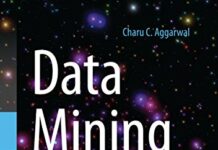
Ebook Info
- Published: 2018
- Number of pages: 512 pages
- Format: PDF
- File Size: 8.18 MB
- Authors: Charu C. Aggarwal
Description
This book covers both classical and modern models in deep learning. The primary focus is on the theory and algorithms of deep learning. The theory and algorithms of neural networks are particularly important for understanding important concepts, so that one can understand the important design concepts of neural architectures in different applications. Why do neural networks work? When do they work better than off-the-shelf machine-learning models? When is depth useful? Why is training neural networks so hard? What are the pitfalls? The book is also rich in discussing different applications in order to give the practitioner a flavor of how neural architectures are designed for different types of problems. Applications associated with many different areas like recommender systems, machine translation, image captioning, image classification, reinforcement-learning based gaming, and text analytics are covered. The chapters of this book span three categories:The basics of neural networks: Many traditional machine learning models can be understood as special cases of neural networks. An emphasis is placed in the first two chapters on understanding the relationship between traditional machine learning and neural networks. Support vector machines, linear/logistic regression, singular value decomposition, matrix factorization, and recommender systems are shown to be special cases of neural networks. These methods are studied together with recent feature engineering methods like word2vec.Fundamentals of neural networks: A detailed discussion of training and regularization is provided in Chapters 3 and 4. Chapters 5 and 6 present radial-basis function (RBF) networks and restricted Boltzmann machines.Advanced topics in neural networks: Chapters 7 and 8 discuss recurrent neural networks and convolutional neural networks. Several advanced topics like deep reinforcement learning, neural Turing machines, Kohonen self-organizing maps, and generative adversarial networks are introduced in Chapters 9 and 10.The book is written for graduate students, researchers, and practitioners. Numerous exercises are available along with a solution manual to aid in classroom teaching. Where possible, an application-centric view is highlighted in order to provide an understanding of the practical uses of each class of techniques.
User’s Reviews
Reviews from Amazon users which were colected at the time this book was published on the website:
⭐I have familiarity with data mining concepts and general machine learning. I am a practitioner of Machine Learning and am very interested in applying these models to real world problems. The purpose of buying this book was two fold: 1. I wanted to get an understanding of deep learning – how neural networks work and how they can be put to use and 2. How do neural networks compare in relation to other conventional machine learning models? How are they related and where is their place in the field of machine learning?From either point of view, I feel that every penny I spent on buying the book is worth more than its weight in gold. This book starts with a fairly detailed introduction into simple neural networks. The early chapters establish crucial and very useful connections between conventional machine learning methods and how neural networks can be built to mimic them. Ample examples and details are given to walk the user through intricate scenarios. Example, there is a whole section which unboxes gradient descent and explains the math behind it. There are several places in the book where connections are drawn between neural networks and how they simulate linear regression, logistic regression and SVMs. Several variants and differences are also explained in great detail. Once these are established, early development in neural networks are addressed – Radial Basis Functions and Restricted Boltzmann Machines are discussed in depth. After setting the fundamentals, the author goes on to address topics in deep learning – starting with RNNs, CNNs, Deep Reinforcement Learning and more advanced topics like GANs.The book also provides and cites ample references which inform the user about the historical progress and development of the field. The references have been compiled with great care and so are the diagrams. Very detailed explanations are provided to connect practicality of the methods. For instance, for activation functions, several examples are provided based on what functions are used in practice and how the choice impacts the complexity of models and what conventional ML models they map to.A more detailed review will follow as I progress more through the book but for starters, this is a great book to buy – be it for reference, or teaching a course or for getting to know the field. If you have experience in ML, you will definitely benefit from the insightful connections of neural networks with conventional ML methods. For teaching, the accompanying web page has a wealth of resources in the form of slides, Image sources for pictures in the book to compose your own slides and other files accompanying the book. Definite buy to have in your shelf if you are interested in Deep Learning.
⭐This is modern, comprehensive text on this rapidly evolving topic. There are some good exercises and a very large, up to date and valuable bibliography, including many links to useful websites. Unlike many texts on the subject, mathematical details are included. The author must have had extensive practical experience in constructing, training and deploying neural networks as well as using deep learning techniques. The book is peppered with interesting biographical and historical comments. I think that it is an excellent reference work for an instructor or advanced student. However, the reader should be aware that there are no computer scripts or even pseudocode. Of course, including code would significantly enlarge the already large book. But I suspect that a beginner might not be able to construct a neural network using this book alone. With this caveat I recommend this well-written book.
⭐Great book!!! I have been a practitioner in the field for over 5 years now and my nature of the job borderlines between a general practitioner and a specialist. This book gave me exactly what I wanted …. A vivid explanation of the mathematical foundation behind each technique along with use cases where applicable. The math is just enough and not overwhelming which is great for someone like me who needs to take a 10000 ft view of a problem and suggest a solution with hands on responsibility just enough to guide a tech savvy team.
⭐First of all, this book is very Mathematically grounded , but the author has provided the best explanation yet of Backpropagation using Dynamic Programming approach. I personally loved the chapters on Computational Graphs , Multilayer Perceptrons, Backpropagation and Modern Architectures like Auto-Encoders , GANs, this book also gives the necessary grounding to tackle the research papers and some of the exercises in PyTorch are pretty good if one wants to get their hands dirty
⭐Not sure why some people gave this book a bad review. It’s not great but it’s better than Ians book from 2016 and gives an easier to understand presentation of the basics IMO.That said the chapter on CNNs is not good, while conceptually deriving backprop for CNNs is straight forward the fact the mathematical derivation is missing from the book is pretty bad(though it is also missing from Ians).Basically this book is fine if you approach it like you approach Bishops machine learning book – it’s not a tutorial and it gives an overview of the different areas. Mathematical theory is present but in the later chapters it is sometimes glossed over.
⭐I’ve truly enjoyed this book. I don’t have a mathematical background, so some machine learning techniques can be difficult to understand without a lot of serious effort. I haven’t had that problem with this book. It explains how various neural networks work at a conceptual level, which is a must-have for anyone considering doing serious work in the field. Even though it’s math intensive, I found it very easy to understand and the figures were incredibly helpful in piecing everything together. It is also very comprehensive. For the past year, I have been doing survey research in the field and this book is thorough: it goes in detail on every major model and advancement.Just keep in mind that this is not a technical how-to, it focuses mainly on conceptual understanding.It is not easy to simplify a complex and difficult field in such a well-thought out way. I’d recommend it to researchers, students and everyone else interested in deep learning.
⭐Probably the best book on the subject! Not suited to beginners, BUT this was the first book I read on the subject and although difficult I was able to work through it with the help of Google. Things quickly started to click into place. A must have for anybody seriously interested in NN’s and AI
⭐I’d say it’s a very good reference for deep learning and neural network.The only bit I don’t like is that sometimes the notation (math) is a bit unclear. It would have been useful to have either a first chapter or an appendix explaining the notation used. But don’t get me wrong is still very readable.Apart from this, I’d say the reading is quite smooth and most of the contents is very relevant for anyone who want to learn about the subject, also a very useful reference (NN, Autoencoder, RBF networks, RNN, CNN, GAN… all covered).
⭐An excellent deep learning handbook! It covers all basic subjects and applications of deep learning. Would love to see more advanced topics included in the next version.
⭐Amazing. In-depth explanations of various algorithms and a great way of discovering new algorithms.The math can be a little hard to digest at times but gives lots of references for further research. That said, it’s refreshing to read through each section without needing to read through pages of mathematical notations!
⭐Great
Keywords
Free Download Neural Networks and Deep Learning: A Textbook in PDF format
Neural Networks and Deep Learning: A Textbook PDF Free Download
Download Neural Networks and Deep Learning: A Textbook 2018 PDF Free
Neural Networks and Deep Learning: A Textbook 2018 PDF Free Download
Download Neural Networks and Deep Learning: A Textbook PDF
Free Download Ebook Neural Networks and Deep Learning: A Textbook





